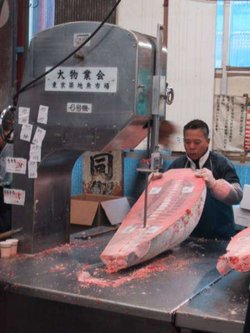Tsukiji fish market
|
|
Tsukiji_as_seen_from_Shiodome.jpg
Tsukiji.FrozenTuna.jpg
Auction_Tsukiji_fishmarket.jpg
The Tokyo Metropolitan Central Wholesale Market, commonly known as the Tsukiji fish market (Japanese: 築地魚市場, Tsukiji uoichiba) is the biggest wholesale fish and seafood market in the world and also one of the biggest markets of any kind in the world.
The market is located in Tsukiji in Tokyo, and is a major attraction for foreign visitors (few Japanese casually visit the market), especially for visitors with jet lag who have arrived from Narita International Airport; the best times to visit are between 5:00AM and 9:00AM.
| Contents |
Location
The Tsukiji fish market is located near the Tsukiji Shijou Station on the Oedo subway line and Tsukiji Station on the Hibiya subway line. The market consists of two parts. There is an inner market where the auctions and most of the processing of the fish takes place, along with a large number of seafood shops. The outer market has many different shops selling Japanese kitchen tools and groceries, and restaurants, especially sushi restaurants. Most of the shops in the outer market close at noon, and in the inner market even earlier.
Economics
The market handles more than 400 different types of seafood from tiny sardines to 300kg tuna, from cheap seaweed to the most expensive caviar. Overall, more than 700,000 metric tons of seafood are handled every year at the three seafood markets in Tokyo, with a total value in excess of 600 billion yen (approximately 6 billion US dollars). Tsukiji alone handles over 2000 metric tons of seafood per day.
Operations
Tsukiji_fish_market_thuna_knife.jpg
The market opens every morning except Sundays and holidays at 3:00 AM with the arrival of the products by ship, truck and plane from all over the world. Particularly impressive is the unloading of tons of frozen tuna. The auction houses (wholesalers known in Japanese as oroshi gyousha) then estimate the value and prepare the incoming products for the auctions. The buyers (licensed to participate in the auctions) also inspect the fish to estimate which fish they would like to bid for and at which price. The auctions start around 5:00 AM and can be visited by the public, but bidding can only be done by licensed participants. These bidders include intermediate wholesalers [nakaoroshi gyousha] who operate stalls within the marketplace, and other licensed buyers who are agents for restaurants, food processing companies, and large retailers.
The auctions usually end around 7:00AM. Afterwards, the purchased fish is either loaded onto trucks to be shipped to the next destination, or on small carts and moved to the many shops located inside of the market. There the shop owners cut and prepare the products for retail. In case of large fishes as for example Tuna, large tools are needed, and frozen tuna is often cut like logs with a large band saw, and unfrozen Tuna is cut using extremely long knives called Oroshi hocho and Hancho hocho.
The market is most busy between 8:00 and 10:AM, and the activity declines significantly afterwards. Many shops start to close around 11:00AM, and the market closes for cleaning around 1:00PM.
Inspectors from the Tokyo Metropolitan Government supervise activities in the market to enforce the Food Hygiene Law.
History
The first market in Tokyo was established by Tokugawa Ieyasu during the Edo period to provide food for Edo castle (nowadays Tokyo). Tokugawa Ieyasu invited fishermen from Tsukudajima, Osaka to Edo in order to provide fish for the castle. Fish not bought by the castle was sold near the Nihonbashi bridge, at a market called uogashi (literally, "fish quay") which was one of many specialized wholesale markets that lined the canals of Edo (as Tokyo was known until the 1870s).
In August 1918, following the so-called "Rice Riots" (Kome Soudai) which broke out in over one hundred cities and towns in protest against food shortages and the speculative practices of wholesalers), the Japanese government was forced to create new institutions for the distribution of foodstuffs, especially in urban areas. A Central Wholesale Market Law was established in March 1923 . The Great Kanto earthquake on September 1, 1923, devastated much of central Tokyo, including the Nihonbashi fish market. In the aftermath of the earthquake, the market was relocated to the Tsukiji district, and after the construction of a modern market facility was completed in 1935, the fish market began operations under the provisions of the 1923 Central Wholesale Market Law. Three markets in Tsukiji, Kanda and Koto began operating in 1935, followed by more markets in Ebara, Toshima, and Adachi. More markets were opened after World War II.
External links
- Official Homepage in English (http://www.tsukiji-market.or.jp/tukiji_e.htm)
- Guide of Tsukiji (http://www.shijou.metro.tokyo.jp/03/03_02_top.html)
- Early Morning in the Fish Market (http://fsweb.berry.edu/academic/HASS/jhickman/tsukuji.html)
- Tsukiji Research Home Page (http://www.people.fas.harvard.edu/~bestor/tsukiji.htm)
Further reading
Tsukiji: The Fish Market at the Center of the World, Theodore C. Bestor, University of California Press, Berkeley, 2004 (ISBN 0520220242)
Template:Commonsde:Tsukiji-Fischmarkt he:שוק טסוקיג'י ja:築地市場

